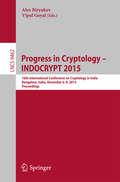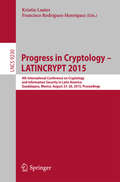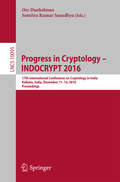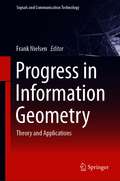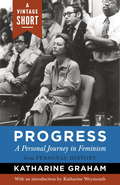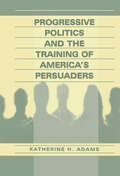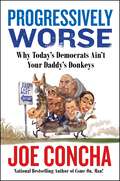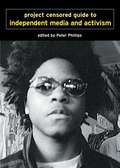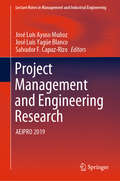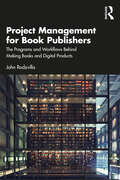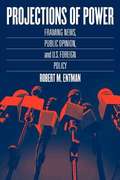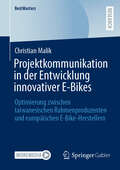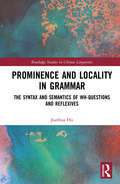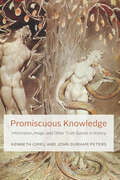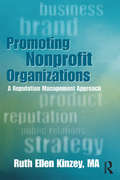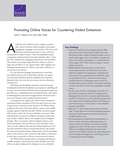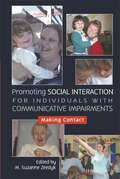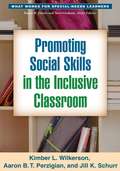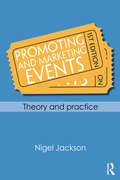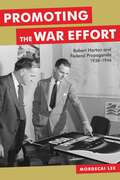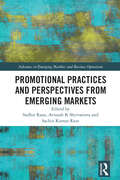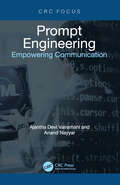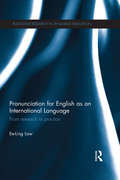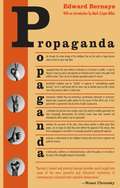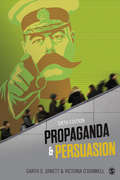- Table View
- List View
Progress in Cryptology -- INDOCRYPT 2015
by Alex Biryukov Vipul GoyalThis bookconstitutes the refereed proceedings of the 16th International Conference onCryptology in India, INDOCRYPT 2015, held in Bangalore, India, in December 2015. The 19 revised full papers presented in this book were carefully reviewed andselected from 60 submissions. The papers are organized in topical sections on publickey encryption; cryptanalysis; side channel attacks; information theoreticcryptography; and lightweight cryptography.
Progress in Cryptology -- LATINCRYPT 2015
by Kristin Lauter Francisco Rodríguez-HenríquezThis book constitutes the proceedings of the 4th International Conference on Cryptology and Information Security in Latin America, LatinCrypt 2015, held in Guadalajara, Mexico, in August 2015. The 20 papers presented were carefully reviewed and selected from 49 submissions. They were organized in topical sections named: cryptographic protocols; foundations; post-quantum cryptography; symmetric key cryptanalysis; we still love pairings; curves in cryptography; and cryptographic engineering.
Progress in Cryptology – INDOCRYPT 2016
by Orr Dunkelman Somitra Kumar SanadhyaThis book constitutes the refereed proceedings of the 17th International Conference on Cryptology in India, INDOCRYPT 2016, held in Kolkata, India, in December 2016. The 23 revised full papers presented in this book were carefully reviewed and selected from 84 submissions. The focus of the conference includes works on Public-Key Cryptography, Cryptographic Protocols, Side-Channel Attacks, Implementation of Cryptographic Schemes, Functional Encryption, Symmetric-Key Cryptanalysis, Foundations, and New Cryptographic Constructions.
Progress in Information Geometry: Theory and Applications (Signals and Communication Technology)
by Frank NielsenThis book focuses on information-geometric manifolds of structured data and models and related applied mathematics. It features new and fruitful interactions between several branches of science: Advanced Signal/Image/Video Processing, Complex Data Modeling and Analysis, Statistics on Manifolds, Topology/Machine/Deep Learning and Artificial Intelligence. The selection of applications makes the book a substantial information source, not only for academic scientist but it is also highly relevant for industry. The book project was initiated following discussions at the international conference GSI’2019 – Geometric Science of Information that was held at ENAC, Toulouse (France).
Progress: A Personal Journey in Feminism
by Katharine Graham Katharine WeymouthAn eBook short.From Katharine Graham's Pulitzer Prize-winning memoir Personal History, a stirring narrative of how the legendary publisher of the Washington Post became a feminist. With an introduction from her granddaughter, Katharine Weymouth, publisher of the Post until 2014. Katharine Graham was the newspaper mogul who piloted the Washington Post through the crises of the Pentagon Papers and Watergate: but first she had to overcome the harsh expectations of a male-dominated industry, and her harshest critic of all--herself. Inheriting ownership of the paper from her father, and assuming its leadership in 1963 after the death of her husband, Philip, Graham found herself the only woman in a man's world--a world, however, that was beginning to change. From Georgetown suppers to board meetings, from The Second Sex to Gloria Steinem, this is the refreshingly honest account of how the most powerful woman in Washington came into her own.
Progressive Politics and the Training of America's Persuaders
by Katherine AdamsAt the beginning of the 20th century, Progressive reformers set up curricula in journalism, public relations, and creative writing to fulfill their own purposes: well-trained rhetors could convince the United States citizenry to accept Progressive thinking on monopolies and unions and to elect reform candidates. Although Progressive politicians and educators envisioned these courses and majors as forwarding their own goals, they could not control the intentions of the graduates thus trained or the employers who hired them. The period's vast panorama of rhetoric, including Theodore Roosevelt's publicity stunts, muckraker exposés, ad campaigns for patent medicines, and the selling of World War I, revealed the new national power of propaganda and the media, especially when wielded by college-trained experts imbued with the Progressive tradition of serving a cause and ensuring social betterment. In this unique volume, Adams' chronicles the creation of this advanced curriculum in speaking and writing during the Progressive era and examines the impact of that curriculum on public discourse. Unlike other studies of writing instruction, which have concentrated on freshman curriculum or on a specific genre, this book provides a historical and cultural analysis of the advanced composition curriculum and of its impact on public persuasion. Adams surveys American instruction at state and private schools across the country, with special attention given to the influential Progressive universities of the Midwest. She draws on a wide variety of primary data sources including college catalogs, course assignments, departmental minutes, speeches, and journals, and includes an extensive bibliography of research sources concerning advanced composition instruction and American rhetoric before World War II. As a resource offering remarkable historical insights on the history of writing instruction in America, this volume is of great interest to scholars and students in rhetoric, communication, and technical writing.
Progressively Worse: Why Today's Democrats Ain't Your Daddy's Donkeys
by Joe ConchaIf John F. Kennedy, Tip O’Neill, or even Bill Clinton were to run as Democrat candidates today, their own party would cancel them in a heartbeat.If the Joe Biden of 1992 were to run today, MSNBC would label him “MAGA Joe.” How did JFK’s party of Catholics and union workers become AOC’s party of privileged Ivy Leaguers with “Queers for Palestine” signs and purple hair?Over the past few decades, Democrats have swung so far to the left that they have little in common with past generations of progressives. In Progressively Worse, bestselling author and Fox News contributor Joe Concha highlights how the Democrats used to:· Care about blue collar workers· Protest against new wars· Defend free speech· Criticize the elites and Wall Street· Want limits on immigrationNow, the party of the hippies is now the party of Hamasniks, and the party of feminists now celebrates male athletes in women’s sports. Though spotlights of key influencers like Gavin Newsom, Rashida Tlaib, Keith Olbermann, and Pete Buttigieg, Progressively Worse lays out the facts every American should know about the Democrat party. It’s not even a party anymore. It’s more like the hangover the day after.
Project Censored Guide to Independent Media and Activism (Open Media Series)
by Peter PhillipsThe independent media are arguably more important than ever today, as corporate media's line reads increasingly like a government press release rather than a free society's analysis of the day's important events. But there's a lot to sort through: Independent newsmagazines and newspapers, local cable-TV access, and independent and microtransmitted radio are everywhere, offering a vast array of news, opinions, and information. New Indymedia activists alone now have direct links to more than sixty-five grassroots news sites around the world. The challenge we are faced with is two-fold: We must make these news sources widely accessible, but we must also find ways to compile, sort, and collectively release this real news to millions of people--a project that this invaluable guide for diversifying your access to information can make much more achievable.
Project Management and Engineering Research: AEIPRO 2019 (Lecture Notes in Management and Industrial Engineering #0)
by José Luis Ayuso Muñoz José Luis Yagüe Blanco Salvador F. Capuz-RizoThis book gathers the best papers presented at the International Congress on Project Management and Engineering, in its 2017 and 2018 editions, which were held in Cádiz and Madrid, Spain. It covers a range of topic areas, including civil engineering and urban planning, product and process engineering, environmental engineering, energy efficiency and renewable energies, rural development, information and communication technologies, and risk management and safety.
Project Management for Book Publishers: The Programs and Workflows Behind Making Books and Digital Products
by John RodzvillaProject Management for Book Publishers provides readers with a solid understanding of efficient processes and workflows for content creation, product development, and the marketing and distribution of both physical and digital products.Digital has brought more data, more training, and more accountability to the publishing process. But it has also shone light on how systems designed initially around print-first publications are ill-equipped to support an industry of now would-be digital media companies. This book addresses some of the major challenges for publishing houses facing this reality, including how to create a digital-aware workflow, implementing quality assurance procedures, and using different management systems to develop an efficient workflow. Beginning by explaining project and product management practices used throughout technology and media companies, it then delves into when and how these principles can be applied to the publishing workflow. Topics covered include Waterfall and Agile Project Management, Scrum methodology, Kanban framework, ebook and audio formats, metadata, quality assurance, crowdfunding, in-app monetization, ONIX, and accessibility. Readers will consider not just how to contend with online platforms that allow authors to publish with the click of a button, and audiences accustomed to accessing content across multiple platforms and formats, but also challenges arising from factors such as the data-driven acquisitions model in libraries, the downward spiral of sales in college bookstores, the call for accessibility, and the need for fluid content systems that can work with different publishing databases and software.Written for publishing professionals at all levels, this book will also help advanced students of Publishing and Book Studies navigate best practices for project management in the modern publishing landscape.
Projections of Power: Framing News, Public Opinion, and U.S. Foreign Policy
by Robert M. EntmanTo succeed in foreign policy, U.S. presidents have to sell their versions or framings of political events to the news media and to the public. But since the end of the Cold War, journalists have increasingly resisted presidential views, even offering their own spin on events. What, then, determines whether the media will accept or reject the White House perspective? And what consequences does this new media environment have for policymaking and public opinion? To answer these questions, Robert M. Entman develops a powerful new model of how media framing works -- a model that allows him to explain why the media cheered American victories over small-time dictators in Grenada and Panama but barely noticed the success of far more difficult missions in Haiti and Kosovo. Discussing the practical implications of his model, Entman also suggests ways to more effectively encourage the exchange of ideas between the government and the media and between the media and the public. His book will be an essential guide for political scientists, students of the media, and anyone interested in the increasingly influential role of the media in foreign policy.
Projektkommunikation in der Entwicklung innovativer E-Bikes: Optimierung zwischen taiwanesischen Rahmenproduzenten und europäischen E-Bike-Herstellern (BestMasters)
by Christian MalikDie erfolgreiche Zusammenarbeit zwischen Fahrradmarken und Rahmenherstellern spielt eine zentrale Rolle für die Entwicklung innovativer E-Bikes. In diesem Buch wird die Projektkommunikation als entscheidender Faktor für eine effiziente Kooperation untersucht. Ziel ist es, Kommunikationsprozesse zu identifizieren, die zu reibungslosen Abläufen und erfolgreichen Projektergebnissen führen. Auf Basis von Experteninterviews werden Herausforderungen und Best Practices in der Kommunikation zwischen den beiden Akteuren analysiert. Die Arbeit liefert konkrete Empfehlungen zur Optimierung der Projektkommunikation, um Missverständnisse zu reduzieren, Entscheidungswege zu verkürzen und die Produktentwicklung effizienter zu gestalten. Die Ergebnisse bieten wertvolle Einblicke für Unternehmen der E-Bike-Branche, die ihre Zusammenarbeit durch zielgerichtete Kommunikation verbessern und ihre Wettbewerbsfähigkeit stärken möchten.
Prominence and Locality in Grammar: The Syntax and Semantics of Wh-Questions and Reflexives (Routledge Studies in Chinese Linguistics)
by Jianhua HuThis book challenges the current consensus on the analysis of wh-questions and reflexives from the perspective of the syntax-semantics interface. An integrated approach incorporating analyses of the interaction between different levels of linguistic knowledge is proposed. It argues that the derivation and interpretation of wh-questions and reflexives are not purely syntactic in nature but are regulated by principles operating at the syntax-semantics interface. Two general principles underlying our knowledge of language and cognition are proposed in this work. One is the Principle of Locality, and the other is the Principle of Prominence. It shows that although wh-quantification and reflexivization belong to two different domains of study in generative grammar, their derivation and interpretation are basically constrained by the complex interaction between prominence and locality in grammar. The first part of the book discusses how wh-questions are formed and interpreted in Chinese and English and shows that the formation and interpretation of wh-questions are constrained by the interaction between prominence and locality. It is shown that in wh-interpretation prominence is used to define the set generators so as to licence other wh-words in the pair-list reading in multiple wh-questions. It also discusses wh-island effects in English and Chinese, and unlike previous claims made in the literature (cf. Huang 1982a, 1982b), it argues that the so-called wh-island effects in English are also observed in Chinese. The second part of the book investigates the role that prominence and locality play in reflexive binding. It is shown that in reflexive binding, the binding domain of the reflexive is defined by prominence. It proposes a unified account for both the noncontrastive compound reflexive and the bare reflexive in Chinese and shows that they are constrained by the same reflexive binding condition proposed in this work, though they employ different definitions of the most prominent NPs to determine their binding domains. Prominence and Locality in Grammar: The Syntax and Semantics of Wh-Quesitons and Reflexives is an important theoretical contribution to the syntax-semantics interface studies and can serve as a valuable text for graduate students and scholars in the field of Chinese, linguistics, and cognitive science.
Promiscuous Knowledge: Information, Image, and Other Truth Games in History
by John Durham Peters Kenneth Cmiel“[A] lively account of the cultural and intellectual history of how Americans have lived with image and information since the mid-nineteenth century.” —Peter Simonson, author of Refiguring Mass CommunicationSergey Brin, a cofounder of Google, once compared the perfect search engine to “the mind of God.” As the modern face of promiscuous knowledge, however, Google’s divine omniscience traffics in news, maps, weather, and porn indifferently. This book, begun by the late Kenneth Cmiel and completed by his close friend John Durham Peters, provides a genealogy of the information age from its early origins up to the reign of Google. It examines how we think about fact, image, and knowledge, centering on the different ways that claims of truth are complicated when they pass to a larger public. To explore these ideas, Cmiel and Peters focus on three main periods—the late nineteenth century, 1925 to 1945, and 1975 to 2000, with constant reference to the present. Cmiel’s original text examines the growing gulf between politics and aesthetics in postmodern architecture, the distancing of images from everyday life in magical realist cinema, the waning support for national betterment through taxation, and the inability of a single presentational strategy to contain the social whole. Peters brings Cmiel’s study into the present moment, providing the backstory to current controversies about the slipperiness of facts in a digital age.A hybrid work from two innovative thinkers, Promiscuous Knowledge enlightens our understanding of the internet and the profuse visual culture of our time.“With a clear voice and careful evidence, Promiscuous Knowledge offers fascinating glimpses into important people and practices from across the centuries.” —Fred Turner, author of From Counterculture to Cyberculture
Promoting Nonprofit Organizations: A Reputation Management Approach
by Ruth Ellen KinzeyPromoting Nonprofit Organizations is a practical guide to developing and implementing a strategic public relations program to enhance a nonprofit’s reputation. The ways in which businesses – both for-profit and not-for-profit – communicate with customers has changed dramatically in recent years. Coupled with economic uncertainty, nonprofits have had to adopt a leaner operational mode, further underlining the need for organizations to take advantage of all the promotion strategies available to them. This book: Discusses why public relations and reputation management go hand-in-hand with marketing efforts Offers a step-by-step guide to develop a public relations strategy Considers the importance of nonprofit sustainable citizenship Provides tips for reputation enhancement using a range of tools, such as social media and board ambassadorship Guides the reader in developing a reputation approach to crisis communication management Highly practical in its approach, this book is a great guide for students in public relations and nonprofit management courses, as well as for professionals seeking to enhance the success of their nonprofit organization.
Promoting Online Voices for Countering Violent Extremism
by Peter Chalk Todd C. Helmus Erin YorkAmerican Muslims have played an important role in helping to counter extremism and are increasingly using social media to this end. RAND researchers reviewed literature and interviewed American Muslims experienced in social media to understand and explain key challenges facing these Muslim activists, and to identify ways in which the public and private sector can help empower these voices online.
Promoting Social Interaction for Individuals with Communicative Impairments: Making Contact
by Martyn Jones Hilary Kennedy Phoebe Caldwell Suzanne Zeedyk Pete CoiaAll humans have an innate need and ability to communicate with others, and this book presents successful approaches to nurturing communicative abilities in people who have some type of communication impairment. The contributors look at a wide range of approaches, including intensive interaction, co-creative communication, sensory integration and music therapy, for a variety of impairments, including autism, profound learning disabilities, deafblindness, severe early neglect and dementia. This wide perspective provides insight into what it feels like to struggle with a communicative impairment, and how those who work with and care about such individuals can and should think more creatively about how to make contact with them. Covering both the theory and practical implementation of different interventions, this book will be invaluable for health and social work professionals, psychologists, psychotherapists, counsellors, speech and language therapists, as well as researchers, teachers and students in these fields.
Promoting Social Skills in the Inclusive Classroom
by Jill K. Schurr Aaron B. Perzigian Kimber L. WilkersonThis indispensable book presents evidence-based tools and strategies for improving the social skills of all members of the inclusive classroom (K-6), especially students experiencing difficulties in this area. The authors explain why social competence is critical to school success and describe interventions, curricula, and instructional approaches that have been shown to be effective at the schoolwide, classroom, and individual levels. Procedures for conducting assessments and developing individualized intervention plans are detailed. Reproducible forms can be downloaded and printed in a convenient 8 1/2" x 11" size.
Promoting and Marketing Events: Theory and Practice
by Nigel JacksonThis accessible book introduces students to the theories, concepts and skills required to promote an event successfully. To promote an event effectively it is essential to understand marketing, but it is also important to recognise that it is not just consumers who are the audience: other publics who may not necessarily attend can have a fundamental effect on the success of an event as well. Uniquely therefore, this book covers two related themes: marketing and public relations in an events context. This will offer events planners a comprehensive guide on how to promote events to a range of audiences, and on how to use this to manage an event's long-term reputation. The book focuses on core marketing and PR current theory specifically relevant to the events industry and introduces topics such as marketing strategy, the consumer, marketing PR and how to use the internet to promote events. It integrates a range of international case studies from small-scale events to mega-events to help show how theory can be applied in practice. It further includes inserts of interviews with practitioners in the field, to offer insight into the realities of event communication and to show how to overcome potential pitfalls. Learning outcomes, discussion questions and further reading suggestions are included to aid navigation throughout the book, spur critical thinking and further students' knowledge. The book is essential reading for all students studying Events Management, and provides valuable reading for students, academics and practitioners interested in marketing and public relations in general.
Promoting the War Effort: Robert Horton and Federal Propaganda, 1938-1946 (Media and Public Affairs)
by Mordecai LeeThough historians have largely overlooked Robert Horton, his public relations campaigns remain fixed in popular memory of the home front during World War II. Utilizing all media -- including the nascent technology of television -- to rally civilian support, Horton's work ranged from educational documentary shorts like Pots to Planes, which depicted the transformation of aluminum household items into aircraft, to posters employing scare tactics, such as a German soldier with large eyes staring forward with the tagline "He's Watching You." Iconic and calculated, Horton's campaigns raise important questions about the role of public relations in government agencies. When are promotional campaigns acceptable? Does war necessitate persuasive communication? What separates information from propaganda? Promoting the War Effort traces the career of Horton -- the first book-length study to do so -- and delves into the controversies surrounding federal public relations.A former reporter, Horton headed the public relations department for the U.S. Maritime Commission from 1938 to 1940. Then -- until Pearl Harbor in December 1941 -- he directed the Division of Information (DOI) in the Executive Office of the President, where he played key roles in promoting the New Deal, President Franklin D. Roosevelt's unprecedented third-term reelection campaign, and the prewar arms-production effort. After Pearl Harbor, Horton's DOI encouraged support for the war, primarily focusing on raising civilian and workforce morale. But the DOI under Horton assumed a different wartime tone than its World War I predecessor, the Committee on Public Information. Rather than whipping up prowar hysteria, Horton focused on developing campaigns for more practical purposes, such as conservation and production. In mid-1942, Roosevelt merged the Division and several other agencies into the Office of War Information. Horton stayed in government, working as the PR director for several agencies. He retired in mid-1946, during the postwar demobilization.Promoting the War Effort recovers this influential figure in American politics and contributes to the ongoing public debate about government public relations during a time when questions about how facts are disseminated -- and spun -- are of greater relevance than ever before.
Promotional Practices and Perspectives from Emerging Markets (Advances in Emerging Markets and Business Operations)
by Sudhir Rana Avinash K Shrivastava Sachin Kumar RautThis volume explores the dynamic nature of emerging markets, which constitute a major share of global GDP, with a focus on the opportunities for growth and the challenges for businesses in meeting the needs of a diverse set of consumers. With the objective to ensure sustainable growth, there is a need for multinationals belonging to and working in emerging economies to learn best practices and continuously evolve. To conduct business in both urban and rural areas, marketing and promotions are potent tools when applied correctly to portray the right brand image. The book studies recent trends and developments in promotional practices as business strategy, sustainability, and innovation across businesses, including retail, textile, and digital technology. It highlights the path that managers should take in order to better understand the potential of distinct market segments and take marketing managerial decisions accordingly. This book will be useful to scholars and researchers of marketing, management studies, business management, financial management, business economics, international business, finance, digital technologies, development studies, and economics. It will also interest policymakers and practitioners in the field.
Prompt Engineering: Empowering Communication
by Anand Nayyar Ajantha Devi VairamaniPrompt engineering engages as a transformative approach to enhancing interaction, creativity, and innovation. From business and healthcare to education, law, and beyond, prompt engineering is a versatile toolkit for navigating complex challenges and driving meaningful change.This book delves into the intricacies of prompt engineering, providing insights, techniques, and practical examples for leveraging prompts effectively. It explores the evolution of prompt engineering, from its early antecedents to its contemporary applications with advanced language models like ChatGPT. Readers will discover how prompts can enhance communication, foster creativity, facilitate problem-solving, and empower professionals across diverse domains.This book is your gateway to unlocking the full potential of prompt engineering. Join the journey of discovery and innovation as the book harnesses the power of prompts to shape a brighter future.
Pronunciation for English as an International Language: From research to practice (Routledge Research in Language Education)
by Ee-Ling LowPronunciation plays a crucial role in learning English as an international language, yet often remains marginalised by educators due to a lack of required phonetic and phonological knowledge. Pronunciation for English as an International Language bridges the gap between phonetics, phonology and pronunciation and provides the reader with a research based guide on how best to teach the English language. The book follows an easy to follow format which ensures the reader will have a comprehensive grasp of each given topic by the end of the chapter. Key ideas explored include: • Articulation of English speech sounds and basic transcription • Connected speech processes • Current issues in English language pronunciation teaching • Multimedia in English language pronunciation practice • Using speech analysis to investigate pronunciation features Using the latest research, Pronunciation for English as an International Language will facilitate effective teaching and learning for any individual involved in teaching English as a second, foreign or international language.
Propaganda
by Edward Bernays"Bernays' honest and practical manual provides much insight into some of the most powerful and influential institutions of contemporary industrial state capitalist democracies."--Noam Chomsky"The conscious and intelligent manipulation of the organized habits and opinions of the masses is an important element in democratic society. Those who manipulate this unseen mechanism of society constitute an invisible government which is the true ruling power of our country."--Edward Bernays, PropagandaA seminal and controversial figure in the history of political thought and public relations, Edward Bernays (1891-1995), pioneered the scientific technique of shaping and manipulating public opinion, which he famously dubbed "engineering of consent." During World War I, he was an integral part of the U.S. Committee on Public Information (CPI), a powerful propaganda apparatus that was mobilized to package, advertise and sell the war to the American people as one that would "Make the World Safe for Democracy." The CPI would become the blueprint in which marketing strategies for future wars would be based upon.Bernays applied the techniques he had learned in the CPI and, incorporating some of the ideas of Walter Lipmann, became an outspoken proponent of propaganda as a tool for democratic and corporate manipulation of the population. His 1928 bombshell Propaganda lays out his eerily prescient vision for using propaganda to regiment the collective mind in a variety of areas, including government, politics, art, science and education. To read this book today is to frightfully comprehend what our contemporary institutions of government and business have become in regards to organized manipulation of the masses.This is the first reprint of Propaganda in over 30 years and features an introduction by Mark Crispin Miller, author of The Bush Dyslexicon: Observations on a National Disorder.
Propaganda & Persuasion
by Dr Garth S. Jowett Victoria J. O'DonnellPropaganda and Persuasion, Sixth Edition, by Garth S. Jowett and Victoria O’Donnell, is the only book of its kind to comprehensively cover the history of propaganda and offer insightful definitions and methods to analyze it. Fascinating examples, from ancient times to present day, facilitate a solid understanding of what propaganda is. The book includes current research in propaganda and persuasion, discusses the use of propaganda in psychological warfare, and offers students a systematic approach to analyzing the propaganda and persuasion they will encounter in everyday life.
